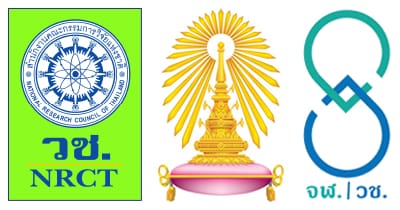แผนงานยุทธศาสตร์เป้าหมาย (Spearhead) ด้านสังคม แผนงานการบริหารจัดการน้ำ (Spearhead Research Program on Water Management)
หลักการและเหตุผล
ตามที่ยุทธศาสตร์ชาติ 20 ปี แผนพัฒนาเศรษฐกิจและสังคมแห่งขาติฉบับที่ 12 และยุทธศาสตร์การบริหารจัดการทรัพยากรน้ำให้ความสำคัญกับทรัพยากรน้ำที่เป็นปัจจัยการผลิตเพื่อการเติบโตทางเศรษฐกิจและอีกด้านคือทรัพยากรที่เป็นทั้งภัยน้ำ ทั้งภัยแล้งและภัยน้ำท่วม โดยมีความเชื่อมโยงผลประโยชน์และความอยู่เย็นเป็นสุขของประชาชนร่วมด้วย ดังนั้น ยุทธศาสตร์ทุกระดับจึงเน้นการสร้างความมั่นคงด้านน้ำและวางระบบบริหารจัดการในลุ่มน้ำหักและลุ่มน้ำสาขาทั้งด้านอุปสงค์และอุปทาน จึงได้กำหนดยุทธศาสตร์การบริหารจัดการทรัพยากรน้ำเป็นเป้าหมายเพื่อลดค่าเฉลี่ยปริมาณการใช้น้ำลงร้อยละ 15 และปริมาณน้ำที่นำไปใช้ประโยชน์จากแหล่งน้ำต้นทุนเพิ่มเป็นร้อยละ 85 นอกจากนี้ ในประเด็นยุทธศาสตร์การบริหารจัดการน้ำมีวัตถุประสงค์เพื่อสร้างองค์ความรู้และนวัตกรรมให้ประเทศมีทรัพยากรน้ำทั้งในเชิงปริมาณและคุณภาพที่สามารถรองรับการเติบโตในอนาคต ด้วยการบริหารจัดการที่มีประสิทธิภาพและยั่งยืน
ด้วยเหตุนี้ตาม คำสั่งหัวหน้าคณะรักษาความสงบแห่งชาติ ที่ 62/2559 เรื่อง การปฏิรูประบบวิจัยและนวัตกรรมของประเทศ ลงวันที่ 6 ตุลาคม พ.ศ.2559 กำหนดสภานโยบายวิจัยและนวัตกรรมแห่งชาติมีหน้าที่และอำนาจกำหนดระบบการจัดสรรและบริหารงบประมาณแบบบูรณาการที่มุ่งผลสัมฤทธิ์ในลักษณะเป็นก้อน (Block Grant) ตามโปรแกรมวิจัยและนวัตกรรม (Program-base) ให้สอดคล้องกับระบบวิจัยและนวัตกรรมของประเทศและยุทธศาสตร์วิจัยและนวัตกรรมรายสาขา รวมทั้งกำหนดระบบการติดตามและประเมินผลที่มีความต่อเนื่อง ซึ่งเป็นที่มาของ “โครงการวิจัยเข็มมุ่ง ด้านสังคม การบริหารจัดการน้ำ” ซึ่งจะเป็นการให้ทุนแบบใหม่ภายใต้การบริหารงานวิจัยแบบใหม่ เพื่อให้เกิดองค์ความรู้และนวัตกรรมให้ประเทศมีทรัพยากรน้ำทั้งในเชิงปริมาณและคุณภาพที่สามารถรองรับการเติบโตในอนาคตด้วยการบริหารจัดการที่มีประสิทธิภาพและยั่งยืน โดยมั่งเน้นแผนงานวิจัยและนวัตกรรมที่สำคัญและเป็นรูปธรรม มีเป้าหมายที่ชัดเจนและวัดผลได้ด้วยตัวชี้วัดที่สะท้อนการดำเนินงานตามแผนงานวิจัย
เป้าหมายของแผนงานการบริหารจัดการน้ำ ภายใต้กรอบระยะเวลา 3 ปีที่ประธานบริหารแผนงาน (Program Chair: PC) ตั้งไว้ประกอบด้วย
1) ค่าเฉลี่ยการสูญเสียน้ำจากระบบส่งน้ำ (ในภาคเกษตร ภาคอุตสาหกรรม และภาคครัวเรือน) ในกลุ่มพื้นที่ภาคกลางตอนบน ลดลงร้อยละ 15 จากอัตราปัจจุบัน
2) ประสิทธิภาพการปล่อยน้ำต้นทุนจากเขื่อนในเขตพื้นที่ภาคกลางตอนบนใต้พื้นที่เขื่อนภูมิพลและเขื่อนสิริกิติ์ เพิ่มขึ้นจากร้อยละ 60 เป็น ร้อยละ 85 และ
3) อัตราการใช้น้ำคาดการณ์ในพื้นที่ EEC ลดลงร้อยละ 15 เทียบกับข้อมูลคาดการณ์ความต้องการใช้น้ำที่เพิ่มขึ้นในพื้นที่ EEC
ด้วยรูปแบบทุน การบริหารงานวิจัยแบบใหม่และเป้าหมายการผลิตองค์ความรู้ด้านการบริหารจัดการน้ำจากงานวิจัยที่มีรูปธรรมและชัดเจนนี้ ส่งผลให้ต้องมีการออกแบบบการบูรณาการทำงานระหว่างประธานแผนงาน ทุกหน่วยงานที่เกี่ยวข้องกับการบริหารจัดการน้ำเพื่อให้เกิดความยั่งยืน นักวิชาการ และหน่วยงานงบประมาณ อย่างชัดเจนและเป็นระบบ เพื่อให้บรรลุเป้าหมายการบริหารทุนวิจัยและงานวิจัย จนนำไปสู่ระบบการบริหารจัดการน้ำอย่างยั่งยืนตามที่แผนงานตั้งเป้าประสงค์ไว้ โดยมีหน่วยบริหารจัดการและส่งมอบผลลัพธ์ (Office Of Delivery Unit: ODU) เป็นหน่วยงานบูรณาการ ประสานงานระหว่างภาคส่วน บริหารจัดการการดำเนินงานให้เป็นไปตามแผน สนับสนุนงบประมาณ ผลักดัน ประเมินผลงานวิจัยให้เกิดการใช้ประโยชน์ และติดตามการใช้ประโยชน์ของผลการวิจัยอย่างเป็นรูปธรรม
Principles and Reasons
According to the 20-year national strategy, the 12th National Economic and Social Development Plan, and the water resource management strategy, water resources are given importance as a factor of production for economic growth, drought, and flood disasters, which are resources that are linked to the benefits and well-being of the people. Therefore, strategies at all levels emphasize creating water security and establishing management systems for supply and demand in the main river basins and tributaries. This has resulted in the determination of water resource management strategies as a target to reduce the average water usage by 15 percent and increase the amount of water utilized from water resources by 85 percent. In addition, the water management strategy aims to create knowledge and innovation for the country to have quantity and quality water resources that can support future growth through efficient and sustainable management.
Therefore, according to the Order of the Head of the National Council for Peace and Order No. 62/2559 on the Reform of the National Research and Innovation System, dated October 6, 2016, the National Research and Innovation Policy Council has the duty and authority to determine the integrated budget allocation and administration system that focuses on results in the form of a block grant according to the research and innovation program (Program-based) to be consistent with the national research and innovation system and the research and innovation strategy in each sector, including determining the continuous monitoring and evaluation system, which is the start of the “Spearhead Research Program on Water Management”. This program is a new type of funding under the new research management to create knowledge and innovation so that the country has quantity and quality in water resources that can support future growth through efficient and sustainable management. It focuses on important and tangible research and innovation plans with clear goals and measurable indicators that reflect the implementation of the research plan.
The goals of the water management plan under the 3-year timeframe set by the Program Chair (PC) include:
1) the average water loss from the water delivery system (in the agricultural, industrial, and household sectors) in the upper central region is reduced by 15 percent from the current rate
2) the efficiency of water release from dams in the upper central region below the Bhumibol and Sirikit Dams is increased from 60 percent to 85 percent
3) the projected water consumption rate in the EEC area is reduced by 15 percent compared to the projected increased water demand in the EEC area.
With this new funding model, research management, and the goal of producing knowledge on water management from tangible and clear research, it is necessary to design an integration work plan between the project chairman, all agencies related to water management, academics, and budget agencies clearly and systematically to create sustainability. This is to achieve the goal of research funding and research management leading to a sustainable water management system as the plan aims, with the Office of Delivery Unit (ODU) as an integrated unit, coordinating between sectors, managing operations to be following the plan, supporting budgets, pushing, evaluating research results for utilization, and on follow up the tangible utilization of research results
วัตถุประสงค์ (Objective)
เพื่อพัฒนาการบริหารจัดการน้ำตามแนวพระราชดำริ (น้ำจากฟ้า น้ำผิวดิน น้ำบาดาล) ให้มีประสิทธิภาพในด้านปริมาณ คุณภาพ เวลา และสถานที่
To develop water management according to the royal initiative (precipitation, surface water, groundwater) to be efficient in terms of quantity, quality, time and place.
เป้าหมายเชิงยุทธศาสตร์ (Strategic Goals)
เพื่อให้ภาคส่วนของสังคมทุกระดับ มีข้อมูลองค์ความรู้และนวัตกรรมที่สามารถแปลงนโยบายการพัฒนาของรัฐบาลและเป้าหมายของยุทธศาสตร์ “ลดค่าเฉลี่ยปริมาณการใช้น้ำในภาคเกษตรกรรม ภาคการผลิต ภาคครัวเรือน ลงร้อยละ 15 และปริมาณน้ำที่นำไปใช้ประโยชน์ ได้จากแหล่งน้ำต้นทุนต่าง ๆ เพิ่มขึ้นเป็น ร้อยละ 85” ไปสู่การปฏิบัติที่เห็นผลในภาพรวม ประเทศ ลุ่มน้ำ เขตเมืองและชุมชน
To provide all levels of society with information, knowledge, and innovation that can transform the government’s development policies and the strategic goals of “reducing the average amount of water use in the agricultural, production and household sectors by 15 percent and increasing the amount of water that can be utilized from various water sources by 85 percent” into effective practices at the national, river basin, urban and community levels.
